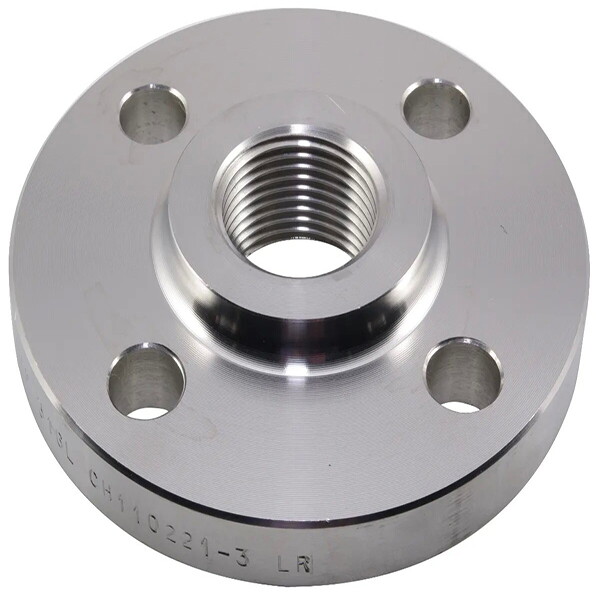Threaded Flanges: Basics and Applications
Threaded flanges, as a special type of pipe fitting, play a significant role in pipe connections. With their unique design and superior performance, they make pipe connections more convenient and efficient. This article explores the design characteristics, advantages, disadvantages, and suitable applications of threaded flanges.

Design Characteristics and Working Principle
The design concept of threaded flanges can be compared to slip-on flanges or socket weld flanges. Their main feature lies in the ability to connect directly to the pipe without welding. The connection is achieved by setting specific conical threads inside the flange bore. This particular shape of tapered threads is designed to be installed on pipes with corresponding external threads, ensuring a tight connection between the flange and the pipe while maintaining stability.
Connection Quality and Sealing Performance
To ensure connection quality, additional sealing weld seams may sometimes be applied in the interface section, complementing the threaded pipe flanges. This not only enhances the connection strength between the pipe and the flange but also further improves the sealing performance of the system, preventing gas or liquid leaks at the connection point and ensuring the normal operation of the system.
Analysis of Advantages and Disadvantages
Threaded flanges exhibit a range of unique advantages and disadvantages, necessitating consideration based on specific application scenarios.
1. Advantages:
Ease of Installation and Disassembly: Effortless installation and disassembly without the need for welding, facilitating maintenance and repairs.
Suitability for Restricted Areas: Particularly suitable for hazardous welding environments.
Applicability to High-Pressure Systems: Suitable for small-diameter, high-pressure temperature applications, avoiding issues associated with welding.
Use with Special Materials: Can be employed with materials challenging to weld successfully.
No Need for Special Equipment: Due to the absence of welding requirements, specialized welding equipment or skilled welders are not necessary.
2. Disadvantages:
Inappropriateness for Large Pipes: Not suitable for large pipe diameters or high-temperature applications, as cutting pipe threads may compromise strength.
Unsuitability for High-Temperature Fluctuations: Ineffective for applications with extreme temperature fluctuations, as the repeated expansion and contraction of the pipe may lead to threaded connection leaks.
Risk of Thread Damage: Risk of damaging threads during alignment and bolt tightening processes, potentially requiring replacement or repairs.
Alignment Challenges: Achieving accurate alignment may be challenging, and misalignment may lead to leaks.
Potential Leakage Over Time: Threaded connections may corrode or wear over time, resulting in potential leaks.
Unsuitability for High-Temperature Fluctuations: Ineffective for applications with extreme temperature fluctuations, as the repeated expansion and contraction of the pipe may lead to threaded connection leaks.
Risk of Thread Damage: Risk of damaging threads during alignment and bolt tightening processes, potentially requiring replacement or repairs.
Alignment Challenges: Achieving accurate alignment may be challenging, and misalignment may lead to leaks.
Potential Leakage Over Time: Threaded connections may corrode or wear over time, resulting in potential leaks.
Application Scenarios
Threaded flanges are most suitable for environments requiring high pressure, small diameter, and non-fluctuating temperatures or in situations where welding is hazardous or inconvenient. Limitations lie in their suitability for larger pipe systems, high-temperature fluctuations, and the potential for long-term sealing issues.
As a vital component in pipeline connections, understanding the design and application requirements of threaded flanges is crucial. A comprehensive knowledge of their advantages, disadvantages, and suitability for specific scenarios contributes to ensuring the safe operation and effective maintenance of pipeline systems.
Related News
- Failure and Crack Analysis of an EO/EG Unit Tower Inlet Flange
- Pipe Flange Bolt Tightening in LNG Projects: Key Considerations
- Ultrasonic Testing of High-Neck Flange Welds
- Underwater Flange Connection Methods for Submarine Pipelines
- Key Technologies for Pressure Vessel Testing and Flange Connection Design
- Installation of Main Bolts for Lap Joint Flange in High-Temperature Gas-Cooled Reactors
- Structural Design and Finite Element Analysis of Anchor Flanges
- Key Welding Technology for High-Neck Flange and Steel Pipe Joints
- The Design and Calculation of Stamped Lap Joint Flanges
- Development of Manufacturing Large Anchor Flanges
